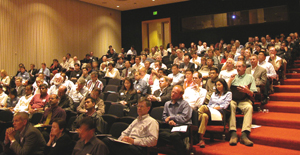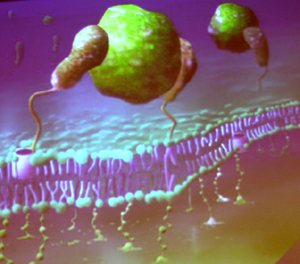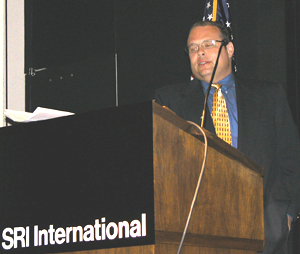Creating the ‘world’s leading nanotechnology cluster’
June 20, 2003 | Source: KurzweilAI
The convergence of biotech, infotech and nanotech in Northern California is the next big thing, according to speakers at a June 18 meeting organized by the Northern California Nanotechnology Initiative (NCnano).
This was the first in a series of Nanotechnology Leadership Conferences designed to bring together investors, entrepreneurs, and execs from companies and research labs to “create the world’s leading nanotechnology cluster.”
The event showcased nanotech-related intellectual property assets in the greater Bay Area, featuring speakers from leading research institutions (NASA Ames, UC Berkeley, UC Davis, Lawrence Livermore, Lawrence Berkeley National Labs, and SRI International) as well as private industry.

Nano investors and developers meet to
strategize the future of Silicon Valley
“Silicon Valley is resting on its laurels,” Chris E. Piercy, President and Chairman of NCnano, told KurzweilAI.net. “The NC Nanotechnology Initiative is designed to invigorate the Bay Area economy by integrating nanotech with our core competencies in infotech and biotech — areas in which we are the leaders in the world.”
Four leading Silicon Valley companies presented their visions of how the Northern California economy might do just that. Dr. Maciek Orczyk, Intel Capital’s Director of Strategic Investments, said silicon technology, enhanced by nanomaterials, “can be extended for the next ten years.” He said Intel is planning a 10-nanometer prototype chip by 2011. “There is plenty of room for nanoengineered materials to play a very important role,” he added.
NEC America senior staff member Ram Mohan said the company is focusing on commercializing its 70,000-plus patents (NEC has the largest number of patents in the world), especially in the nano area, including fuel cells for mobile devices by 2005.
Agilent is developing microfluidics for proteomics and nanopore technology that could eventually “sequence the genome in a few hours” and do DNA analysis in the doctor’s office.
Genencor International, a spinoff of Genentech, has formed a joint venture with Dow Corning to create a merger of silicon chemistry and biotechnology, according to Gary Hooper, VP Business Development.

Genencor's self-assembled biosensor
membrane can detect single molecules
Dr. Stephen Empedocles, Director of Business Development at Nanosys, described its plan for going from the present (nanowires) to the future (nanoprocessors), with spinoff products such as nano-lasers and high-density displays along the way.

Sefton: N. California assets worth trillions to nanotech
NCnano CEO Brian Selton pointed to Nanosys as an example of doing it right: taking advantage of existing intellectual property and resources and incubated with existing fab and labs, instead of trying to develop everything from scratch.
Nanotech startups have major challenges, he said: high costs for facilities, product development, and legal for patents; high burn rate; and increased time to market and market risk. So NCnano is launching NCnano Institute to help startups attract capital and talent, foster cooperation with labs and researchers, commercialize spinouts of new technologies, and cooperate with other regional initiatives.
“The academic, research, and corporate assets of northern California are not duplicable feasibly anywhere else,” he said. “We’re talking about assets that would cost trillions of dollars financially and take decades to duplicate.”